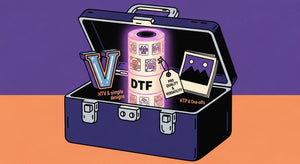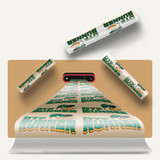Table of Contents
What is DTF Transfer
DTF printing technology: The game-changer in the realm of the textile printing industry. A process bridging direct-to-film (DTF) transfer printing and those substantial printing plates your dad fired-up for you and your teammates when you won that championship last year. Today, this method has grown to be a popular way of printing good quality and durable prints on different types of fabrics. And in this blog post, we bring you the backstory of DTF printing stretching almost all the way back to its inception and move further closer to how it made waves over the years.
The Early Days of Textile Printing
Ranging back to ancient civilizations, the history of Textile printing is infused with creativity. Designs were transferred onto fabric with traditional techniques like block printing and screen printing as well. With the former, it was hard-working and color limited on details. But the controlled room temperature environment set the stage for later printing breakthroughs.
Block Printing
Block printing, one of the oldest methods in textile printing, designs were carved onto wooden blocks and pressed on the fabric after applying ink. Originally employed in old China and India, the process established intricate designs that have graced us with both style and longevity. The process was so long that till date block printing is at best a craft for connoisseurs.
Screen Printing
Next was screen printing, a stencil (usually made of waxed paper) is produced on a fine mesh which contains the design and this rubber blade forces the ink through the stencilled image onto the fabric. It permitted the use of finer details and more colour options than block printing. Screen printing came to prominence in the 20th century as it has the ability for larger batches of cheap and simple design work. There was still a lot that had to be done manually which made it not really doable for smaller quantities or kinds requiring customization.
The Appearance of Digital Printing
Good or bad thing, digital printing played a critical part in the evolution of printed and graphic products since late 20th century. That was all fine and well, but this technology could provide crisper and more colorful prints which addressed new options for customization. The “inkjet” and the “laser” printers were among some of the popular equipment used to print a variety of materials including textiles. Traditional methods of printing like screen printing continue to be the most popular due to its more durable and far cheaper price.
Inkjet Printing
Through the advancement of inkjet printing technology, it is now possible to directly print any high resolution image that you wish onto such various items as fabric. And this resulted in unparalleled versatility for the same level of detail complexity, but just in full-color design. In turn, inkjet printing was not as durable and not as cost efficient for larger productions.
Laser Printing
A last breakthrough in digital printing that affords speedy excessive superb mitting for a lot of packages. Laser printing, predominantly used in paper and synthetic material printing; paved the way for long-term advancement of technology in fabric laser engraving! This was more concise and better prepared for higher-level print which led to unique ways of printing like DTF transfer.
Emergence of DTF Transfer Technology
DTF transfer technology has emerged as one of the most innovative shipments in terms of the textile printing ecosystem. By combining the best parts of digital printing with traditional printing DTF printing brought versatility and quality to a level this industry has never seen before. This discovery of the DTF transfer tech has a very great importance to the industry.
This is done by printing designs on a special film and then use a heat press to transfer them onto fabric The method offered a number of benefits over existing techniques, such as:

- Vibrant Colors: DTF transfers create bright and precise prints.
- Durability: Permanence of the print so it can be washed multiple times.
- Versatility: DTF printing can be used on a wide range of fabrics.
Development and Refinement of DTF Transfer
Initial Innovations
In the initial stages of DTF transfer technology, attempts were being made to refine the printing process without compromising quality and productivity. Various manufacturers tried different types of films and inks which made for results par excellence. The bond with the fabric was improved, when adhesive powders were introduced to adhere the print which contributed to higher longevity.
Advancements in Equipment
As the DTF transfer technology began to take over the market, there were significant improvements in printing equipment. There were even specialized DTF printers that came into existence which allow greater resolutions and printing speeds. The heat press machines also changed, allowing for greater control of the temperature and pressure applied. These changes helped provide an easier and more efficient entry point for businesses large and small to get into DTF printing.
Enhanced Inks and Films
It includes advance equipment improvement and the development of top-notch inks, along with great print films were introduced to enhance the DTF transfer method. Inks for Color vibrancy, Durability, and Fastness However, it does not end there since the film is specifically for complex motifs with lots of detail making DTF printing applicable in a large number of areas — from personalized clothing over to promotional items.
Impact on the Textile Industry
Customization and Personalization
It has been one of the great things that DTF transfer technology has done in the world of textile by allowing us to have customized, personalized products. Fresh and personal designs enable businesses or everyday consumer to come up with the perfect design that fit commercial or trend purposes. This has led to a market which demands more customisation, encouraging the rise of DTF printing services.
Cost-Effectiveness
DTF transfer technology has also made fashion printing more affordable. The fast set-up times and little to no waste produced by DTF printing lower production costs. It is this very affordability that has allowed high-caliber printing for a wider range of people; both hobbyist and professional printers.
Environmental Considerations
Increasing concerns for the environment has made the textile industry to be sustainable. In line with this demand, DTF transfer technology has introduced eco-friendly alternatives. Textile printing is now environmentally-friendly, as water-based inks and films that can be recycled are a thing. The increasing emphasis on sustainability, in turn, continues to appeal print providers overall to the benefits that DTF printing offers. Sustainability is one of the very important step to create a happy world.
Current Trends and Innovations
Integration with Digital Technologies
The combination of DTF transfer tech along with digital tools has really opened up many fronts for any designer or printer. Software improvements help simplify the design and editing process, while automated printing leaves little to chance when it comes to getting an object printed as best as it can be. DTF printing easier with digital innovations in this workflow as it is simpler and easy to understand.
Expansion into New Markets
Conventional DTF transfer technology helps — which opens up this to other industries beyond just textiles. With the use of its DTF printing it prints unique personalized home décor, and branded merchandise to produce specialized high dies quality products. This allowed even more growth and innovation in the sector.
Focus on Quality Control
DTF Transfer Technology and the presence of quality control has been a very important point. Monitoring systems and automatic checks allow the latter to ensure that each corresponding print reaches the highest quality requirements. All of this emphasis on quality has helped to build trust and credibility in DTF printing, making more businesses and consumers comfortable investing into this technology. A higher quality product also means a happier customer.
Future of DTF Transfer Technology
Continued Advancements
DTF transfer in the technology are still have a bright prospect and inexhaustible development. Research is still ongoing with efforts to improve the speed of ink-making, increased levels of resolutions with paper printing and further advances in printing process to improve efficiency. The DTF prints using these inks are also going to play a big part to enhance the quality and work of DTF print.
Increased Accessibility
With the advancement of technology, DTF transfer equipment is being made more available to a better demographic. With reasonably priced eco-solvent printers and heat presses entering the mainstream, small businesses and other entrepreneurs are able to break into the market more easily than previously possible. This technology democratization will likely lead to increased growth, and innovation in the sector. It can get you on your feet running a small business and making great strides.
Sustainable Practices
This trend is set to continue, with the importance of sustainability a key force shaping the development of DTF transfer technology. There is necessity that manufacturers of ink, films and process will support in going green route to reduce the carbon footprints of textile printing. It is a crucial part of the bigger trend towards sustainability that is being observed throughout the industry. Because, you see, there can be few more satisfying feelings than knowing that what you do matters.
Integration with Smart Technologies
One of the areas to watch for the future is exciting development on a mix of DTF transfer technology and smart technologies. For the efficiency, quality control and some flavours of customization IoT and AI in printing processes can have a say. In all likelihood, these advances will lead to the creation of an assortment of highly customizable innovative products.
Potential Challenges
Whilst the potentiality for DTF transfer technology is great, it can also carry its own problems. Innovation, therefore, has evolved very rapidly and so employees need to be constantly in a state of learning. If an enterprise intends to remain on the frontline, it has to increase its training of human resources and improve equipments.
To this I would simply say, And how to do it at the lowest possible cost without ever compromising even an iota of quality; in a world whereby consumer expectations will never decline…lest we forget that every business must always strive for excellence.
Global Impact
This is where DTF transfer technology comes into the big picture globally. With the adoption of this technology by more and more countries, the textile industry will be in for some fierce competition with cooperation across borders. DTF printing, Thus highly-demanded in case of Prototyping or low-volume products as they are better suited for high quality output at desirable lieu prices and everything that tend to be challenge with Traditional silk-screening. This will lead to more innovation and advancement in the industry, with DTF transfer technology being simply a minuscule fraction of it.
And Finally
DTF transfer technology was first introduced to the printing world and has revolutionized textile printing due to its adaptability, quality, and affordability. DTF printing has come a long way from those days and continues to advance with new tech advancements that meet the needs of businesses as well as consumers.
The future is bright for the progression and application of this innovative DTF transfer technology. Naturally, if adopted, a powerful utilization of such advancements will have to branch into textile printing and open up an entire new world of possibilities.
In brief, the historical past of DTF switch expertise proved that innovation could make something attainable. If you are a business owner, designer or just someone who is interested in creating personalized items of very high quality then DTF is the perfect solution to help produce your products one above the rest.
The future of DTF transfer looks good with technology going further flooding more limitless opportunities for creativity and growth in the future. DTF Transfer Technology has a story much like SpaceX, as they started incredibly basic and have made excellent strides since then. Consequently, its future it very much connected with the evolution of this technology as even more advances will be made to leapfrog past and current possibilities being realized in the textile printing business and that we are about to forge within given opportunities and unmanageable challenges together.
The mainstream implementation of the latest breakthroughs in DTF transfer technology will lead to an even greater and more responsible product giving which will enable industry evolution on a grand scale. Career in This Field (Good luck buddies if you wish to make career in this field)






